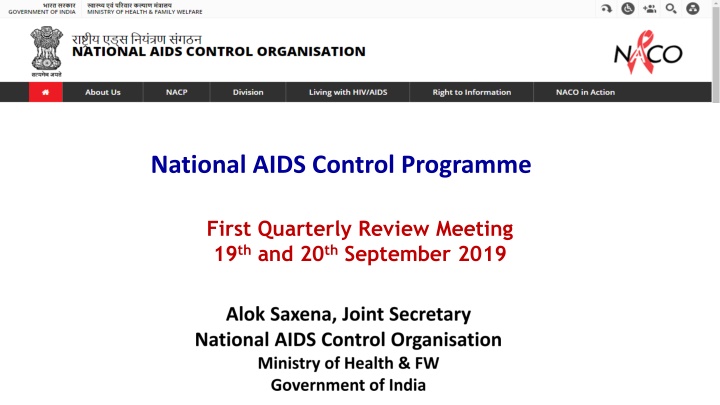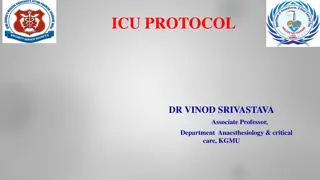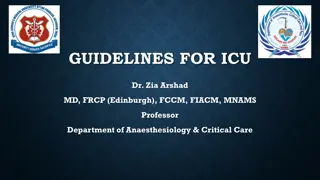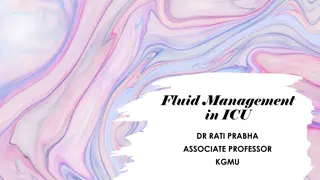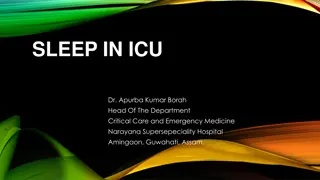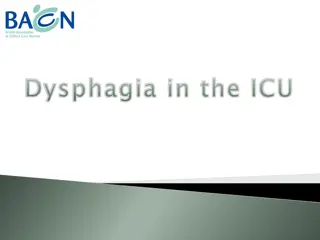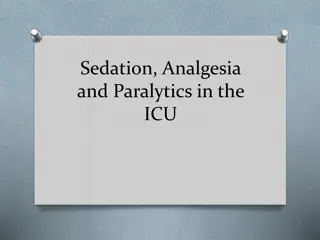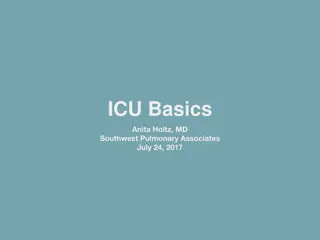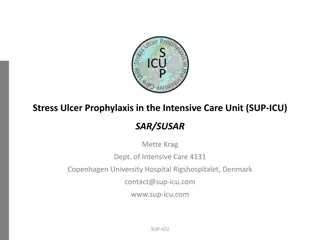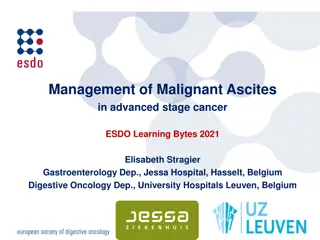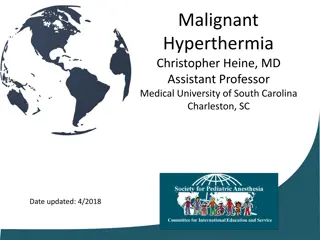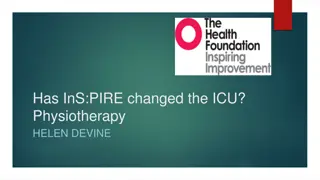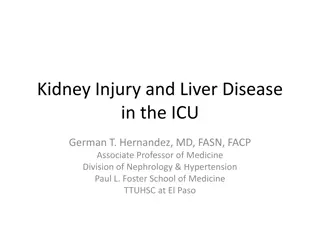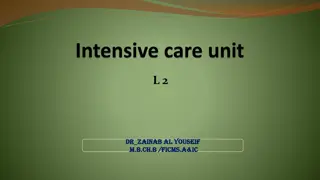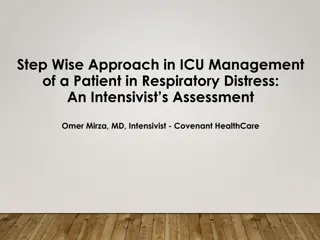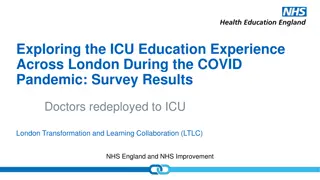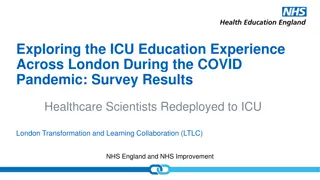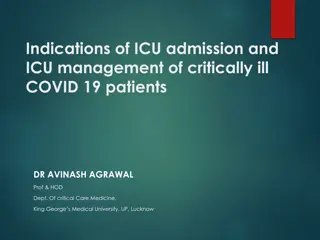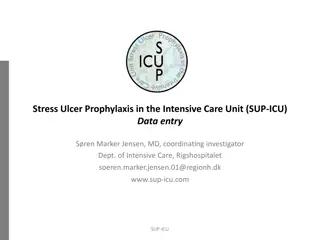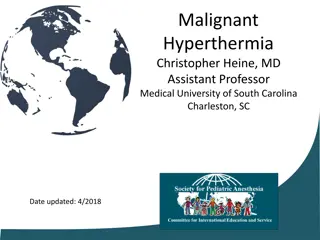Aetiology and Management of Malignant Hyperthermia in ICU
This content discusses thermal disorders, focusing on malignant hyperthermia (MH) in ICU settings. It covers thermoregulation, clinical presentation, differential diagnosis, treatment strategies, and potential complications leading to fatality. Additionally, it delves into the history of MH, highlighting significant events in Australian medical history related to the condition.
Download Presentation

Please find below an Image/Link to download the presentation.
The content on the website is provided AS IS for your information and personal use only. It may not be sold, licensed, or shared on other websites without obtaining consent from the author.If you encounter any issues during the download, it is possible that the publisher has removed the file from their server.
You are allowed to download the files provided on this website for personal or commercial use, subject to the condition that they are used lawfully. All files are the property of their respective owners.
The content on the website is provided AS IS for your information and personal use only. It may not be sold, licensed, or shared on other websites without obtaining consent from the author.
E N D
Presentation Transcript
National AIDS Control Programme First Quarterly Review Meeting 19th and 20th September 2019
Outline National AIDS Control Programme at a glance Agenda Items Vision document Fast Track Targets (90-90-90) The HIV and AIDS (Prevention and Control) Act, 2017 Elimination of Mother to Child Transmission (EMTCT) of HIV Establishment of Anti-Retroviral Therapy (ART) centres in all Medical College Improving Voluntary Blood Donation (VBD)
National AIDS Control Programme: Highlights Fully funded Central Sector Scheme Initiated in 1992 Currently NACP-IV (Extension) 2017-20 under implementation One of the world s largest and most comprehensive HIV/AIDS programmes for key populations and PLHIV Around 10 million of most at risk population covered through 1404 targeted interventions More than 4.5 crore HIV tests in year through 31,377 HIV counselling and testing facilities 14.36 lakh HIV patients on life long free Anti-Retroviral Therapy (ART) (primarily through central government funding at 1,654 ART and Link ART Centers)
National AIDS Control Programme: Achievements Halted and reversed the HIV/AIDS Epidemic 80% reduction in new HIV infections since peak in 1995 (Global average of 47%) 70% reduction in AIDS related deaths since its peak in 2005 (Global average of 51%) From a virtual death sentence to a chronic manageable disease
National AIDS Control Programme: Evolution & Progress NACP-IV Extension (2017-20) Committed to make concrete progress towards End of AIDS by 2030 NACP IV (2012-17) NACP III (2007- 2012) District Focus Consolidate gains NACP II (1999- 2006) Decentralization to states Focus on emerging vulnerabilities, Massive scale up of services with quality assurance mechanisms NACP I (1992- 1999) Centralized approach Test and Treat; Mission Sampark Balance prevention with growing treatment needs, Prevention, Counseling and Testing Launch of treatment services(2004) Universalization of testing of HIV among pregnant women Viral Load Monitoring Awareness and Blood Safety Integrate & Mainstream HIV/AIDS Act
Goals and Targets Goals and Targets End of AIDS epidemic as Public Health threat SDG Goal 3, Target 3.3 2030 Reduce new HIV infections by 75% (Baseline 2010) Achieve treatment targets of 90-90-90 Eliminate Mother to Child Transmission of HIV Eliminate HIV-related stigma and discrimination Fast Track Targets 2020 90-90-90 By 2020 90% of all people living with HIV will know their HIV status 90% of all people with diagnosed HIV infection will receive sustained antiretroviral therapy 90% of all people receiving antiretroviral therapy will have viral suppression
Global and India HIV/AIDS Epidemic Status HIV Prevalence (%) in different population groups (India) Indicator Global (2018) India (2017) People living with HIV (All ages) 3.79 crore 21.40 lakh ANC 0.28 New HIV Infections (All ages) 17 lakh 88,000 Migrants 0.51 PLHIV on ART 2.33 crore 14.36 lakh* AIDS-Related Deaths 7.70 lakh 69,000 Truckers 0.86 * As on July 2019 FSW 1.58 MSM 2.69 Low Prevalence Country (0.22%); Concentrated epidemic TG 3.14 3rd Largest No. of PLHIV in the world Female: 42% of PLHIV; Children: 3% of PLHIV IDU 6.26 Source: HIV Estimations 2017, HIV Sentinel Surveillance 2016-17, NACO
State Wise Adult Prevalence (%) (2017) Adult (15-49 Yrs) Prevalence 2.04 1.43 1.15 0.70 0.63 0.47 0.42 0.33 0.30 0.22 0.22 0.20 0.20 0.19 0.18 0.18 0.17 0.17 0.16 0.15 0.14 0.14 0.13 0.13 0.11 0.11 0.10 0.09 0.09 0.09 0.08 0.06 0.06 0.05 0.05 0.03 Andaman & Nicobar Maharasthra Meghalaya Haryana Kerala Karnataka Goa Bihar Puducherry Uttrakhand Rajasthan Tripura Mizoram Manipur Punjab Arunachal Pradesh Chattisgarh Assam Sikkim Delhi Daman and Diu Telangana Gujarat Odisha Jammu & Kashmir Nagaland Andhra Pradesh Chandigarh Dadra & Nager Havelin Uttar Pradesh Himachal Pradesh Tamil Nadu Jharkhand Madhya Pradesh West Bengal India
State Wise People Living with HIV/AIDS (2017) 329,744 PLHIV Estimates 269,973 247,413 203,723 143,904 141,895 134,020 115,448 91,766 54,682 51,223 45,726 41,357 40,632 36,286 33,367 31,549 26,206 22,755 17,029 16,773 13,539 8,021 5,944 3,148 2,954 2,678 2,141 2,093 1,821 588 519 446 424 230 Karnataka Mizoram Pondicherry Telengana Bihar Chhattishgarh Goa Tripura Manipur Dadra & Nagar Assam Sikkim Arunachal Pradesh Andaman & Nicobar Odisha Uttar Pradesh Delhi Nagaland Himachal Pradesh Tamil Nadu Gujarat Meghalaya Chandigarh Uttarakhand Haryana Jharkhand West Bengal Madhya Pradesh Daman & Diu Maharashtra Kerala Rajasthan Punjab Jammu & Kashmir Andhra Pradesh
Agenda Item 1: Vision document (2019 Agenda Item 1: Vision document (2019- -2024) 2024) Goal: Ending AIDS by 2030 Targets 1. 80% reduction in new HIV infections (against baseline of 2010) 2. Ensuring that 95% of those who are HIV positive in the country know their status, 95% of those who know their status are on treatment and 95% of those who are on treatment have durable viral load suppression. Key performing Indicators (KPI) Parameter(s) and Unit Quantified Target 2nd year (2020-21) 500 15 August 2022 1st year 3rd year (2021-22) 4th year (2022-23) 5th year (2023-24) (2019-20) Number of HIV tests conducted annually (lakhs) Number of PLHIV on ART cumulative (lakhs) Number of PLHIV tested for Viral Load cumulative (lakhs) * Including PLHIV taking ART from private sector 668 450 668 783 900 18.7* 13.9* 15.3* 18.7* 19.7* 20.3* 13 7 11 13 14 16
Context Context SACS are autonomous societies, but function under an Executive Committee Chaired by Principal Secretary, Health/Additional Chief Secretary Central Sector Scheme, funds routed directly to SACS State support is required in the form of Deputation of officers to SACS Use of health systems for testing and treatment Warehouses for drugs/ kits Fast tracking of HIV/AIDS Prevention and control (2017) act Increasing need for resources from States is envisaged HIV Screening Kits at Primary Health Center Level Human Resources at ART Center Opportunistic infections management Social Protection Schemes
Agenda Item 2: Fast Track Targets (90-90-90): National Scenario vis- -vis global average Indicator Target (2020) India (2018-19) Global (2018) Percent PLHIV aware of their HIV Status 90% 79% 79% Out of PLHIV who know their HIV status, % PLHIV on ART 90% 82% 78% Out of PLHIV who are on ART, % PLHIV Virally Suppressed 90% 78%* 86% * Refers to April-August 2019
Agenda Item 2: Fast Track Targets (90-90-90) State Wise (2018-19) State Uttar Pradesh Chhattisgarh Nagaland Karnataka Rajasthan Gujarat Sikkim Andhra Pradesh Delhi Meghalaya J&K Punjab Maharashtra Tamil Nadu Himachal Pradesh India First 90 Second 90 Third 90 72 82 73 76 77 65 85 83 90 87 90 87 94 89 94 75 >95 77 >95 72 >95 77 >95 83 >95 84 >95 84 >95 87 79 82 State West Bengal Arunachal Pradesh Jharkhand Haryana Manipur Odisha Telangana Bihar Goa Tripura Uttarakhand Madhya Pradesh Mizoram Assam Kerala First 90 Second 90 Third 90 34 89 38 63 41 80 47 72 50 86 54 86 59 91 59 79 59 84 62 88 65 79 65 77 67 79 68 77 69 96 79 80 73 69 76 80 89 74 81 82 79 76 82 78 69 78 83 82 75 54 85 79 70 77 86 68 85 76 86 78 86
Areas of Considerations New HIV infections: Timely contracting and release of budget to NGO/CBO Led targeted interventions / Link worker scheme Multi-sectoral response (Education, WCD, Social justice & empowerment, Labor, etc) HIV Testing Testing Enough Testing Right Treatment ICTC-ART Linkage ART Initiation ART Retention ART Adherence Quarterly reviewed with SACS
Agenda Item 3: The HIV and AIDS (Prevention and Control) Act, 2017
The HIV & AIDS (Prevention & Control) Act, 2017 Evolution The HIV & AIDS (Prevention & Control) Act, 2017 Evolution 10th September HIV and AIDS (Prevention and Control) Act, 2017 was brought into force 2018 17th September Central Government Rules (Section 47) were notified after due assent from MoL&J 2018 2019 2019 31st May, 2019 24 States have held state consultations on HIV and AIDS Act, 2017 15 states have finalised the state rules 2 states have already appointed the Ombudsman
The HIV & AIDS (Prevention & Control) Act, 2017 The HIV & AIDS (Prevention & Control) Act, 2017 Hailed as the most progressive such legislation in the world Passed by the Parliament in April 2017; Central Rules notified in September 2018 1. Address stigma & discrimination Create an enabling environment for enhancing access to services Safeguarding rights of PLHIV & those affected by HIV Provide free diagnostic facilities and ART to PLHIVs. Promote safe workplace in healthcare settings to prevent occupational exposure Strengthen system of grievance redressal 2. 3. 4. 5. 6.
State State- -wise status update on framing of Rules (1) wise status update on framing of Rules (1) Status Name of States Rules Notified Punjab , Chhattisgarh Ombudsman deputed Himachal Pradesh, Jharkhand Rules formulated, under approval Goa, Karnataka, Odisha, Haryana, Rajasthan, Madhya Pradesh, Gujarat, Delhi, Nagaland, Maharashtra Rules not formulated Uttar Pradesh, Meghalaya, Bihar, Assam, Arunachal Pradesh Uttarakhand, Andhra Pradesh, Manipur, Mizoram, Sikkim, Tripura, West Bengal, Jammu and Kashmir, Kerala, Telangana Tamil Nadu, Rest of UTs
Agenda Item 4: Elimination of Mother to Child Transmission (EMTCT)
Agenda Item 4: Elimination of Mother to Child Transmission (EMTCT) One of the 2020 fast-track targets Antenatal care coverage (at least one visit) of > =95% Coverage of HIV testing of pregnant women of > =95% Antiretroviral treatment coverage of HIV-positive pregnant women of > =95% % pregnant women tested for HIV against estimated pregnancies 118 114 115 117 132 134 106 105 105 101 100 99 97 95 90 83 83 82 82 81 80 73 71 70 70 69 67 66 60 58 53 48 41 Arunachal Jammu & Maharashtra Chandigarh Punjab Kerala Sikkim Haryana Uttar Pradesh Tripura Delhi Chhatisgarh Jharkhand Tamil Nadu Karnataka Daman & Diu Bihar Meghalaya Himachal Pradesh A & N Islands Andhra Pradesh Uttarakhand Manipur Odisha Nagaland Rajasthan Madhya Pradesh Assam Goa Telangana Mizoram Gujarat West Bengal % PW Tested for HIV India (77%) Uttar Pradesh, Bihar, Madhya Pradesh Critical to achieve EMTCT
Support Required Single window access to HIV testing along with other antenatal testing (Hb, Sugar, Urine, Hepatitis, Syphilis) mismatch in no of pregnant women screened for HIV and Syphilis Whole blood finger prick tests for community-based HIV screening of all pregnant women including village health and nutrition day (VHSND)- Training ANM/ Asha for HIV screening at Village Health and Nutrition Day and linkage of screened reactive for confirmation of the diagnosis. Incentivized referral linkages of positive pregnant women to ARTC may be funded by States.
15 Priority States Strategy for Prevention of Parents to Child Transmission (PPTCT) States PMTCT need [2017] Priority Districts Intensified interventions NHM Collaboration Maharashtra Uttar Pradesh Bihar Andhra Pradesh Karnataka Telangana West Bengal Gujarat Tamil Nadu Rajasthan Madhya Pradesh Jharkhand Odisha Delhi Haryana Total [15 states] India total % contribution of 15 states to India total 2,406 2,286 2,090 1,960 1,951 1,737 1,453 1,297 1,167 959 723 632 603 533 446 20,243 22,677 89.27
Agenda Item 5: Establishment of Anti-Retroviral Therapy (ART) centres in all Medical College
Agenda Item 5: Establishment of Anti-Retroviral Therapy (ART) Board of Governors in super-session of Medical Council of India has issued an amended Gazette notification, dated 25th June 2019, wherein establishment of ART center is mandatory for all Medical Colleges, which are functional for more than 4 years Around 30 Government and 198 private Medical Colleges are functional for more than 4 years and do not have an ART center For medical college (Government or Private) which do not have an ART center, NACO to provide drugs and Technical support while HR and Infrastructure is supported by Institutes For medical colleges (Government) where ART center is already functional with NACO support, Medical Colleges may take over the HR and recurring cost component of ART centers in phased manner For medical colleges (private) where ART center is already functional in PPP mode, it is proposed to continue to same approach
Blood Transfusion Services Blood Transfusion Services Promoting non- remunerated Voluntary Blood Donation; screening for HIV and other Transfusion Transmissible Infection; Promoting Component separation Strengthening Quality management systems and Capacity building Around 12 million blood units collected in 2018-19
Agenda Item 6: Improving Voluntary Blood Donation (VBD) National Blood Transfusion Council (NBTC) of India promote 100% voluntary blood donation in all blood banks across the country Revitalizing and Augmenting State Blood Transfusion Council % Voluntary Blood Donation 100 99 99 98 95 94 93 89 88 87 87 87 86 83 83 81 80 80 79 79 76 75 70 70 70 66 57 52 52 47 41 37 36 33 30 30 Dadra & Nagar Himachal Pradesh Kerala Mizoram Bihar Rajasthan Goa Sikkim Tripura Gujarat Karnataka Puducherry Maharashtra Punjab Manipur Arunachal Pradesh Assam India Tamil Nadu Meghalaya Delhi Telangana Odisha Jammu & Kashmir Andhra Pradesh Nagaland Uttar Pradesh Chhattisgarh Chandigarh A & N Islands Haryana Uttarakhand Daman & Diu Madhya Pradesh Jharkhand West Bengal
Support Required State Blood Transfusion Council (SBTC) is set up in all State and UT under chairpersonship of Prl. Secretary Health, but not optimally functional. Director SBTC to be designated State funds allocated for voluntary blood donation Setting up of up public sector blood banks in districts without blood banks All NBTC norms and guidelines to be complied with Regular meetings of Governing Body of SBTC to be convened (at least two meetings in a year) Observance of World Blood Donation Day and National Voluntary Blood Donation Day
Thank you Thank you 2011: Appreciated in UN General Assembly Special Session 2013: India elected the Chair of UNAIDS Board Wide recognition for supplying ARV medicines for PLHIV across the world Over 20 International governmental delegations visited India; South to South Collaboration
